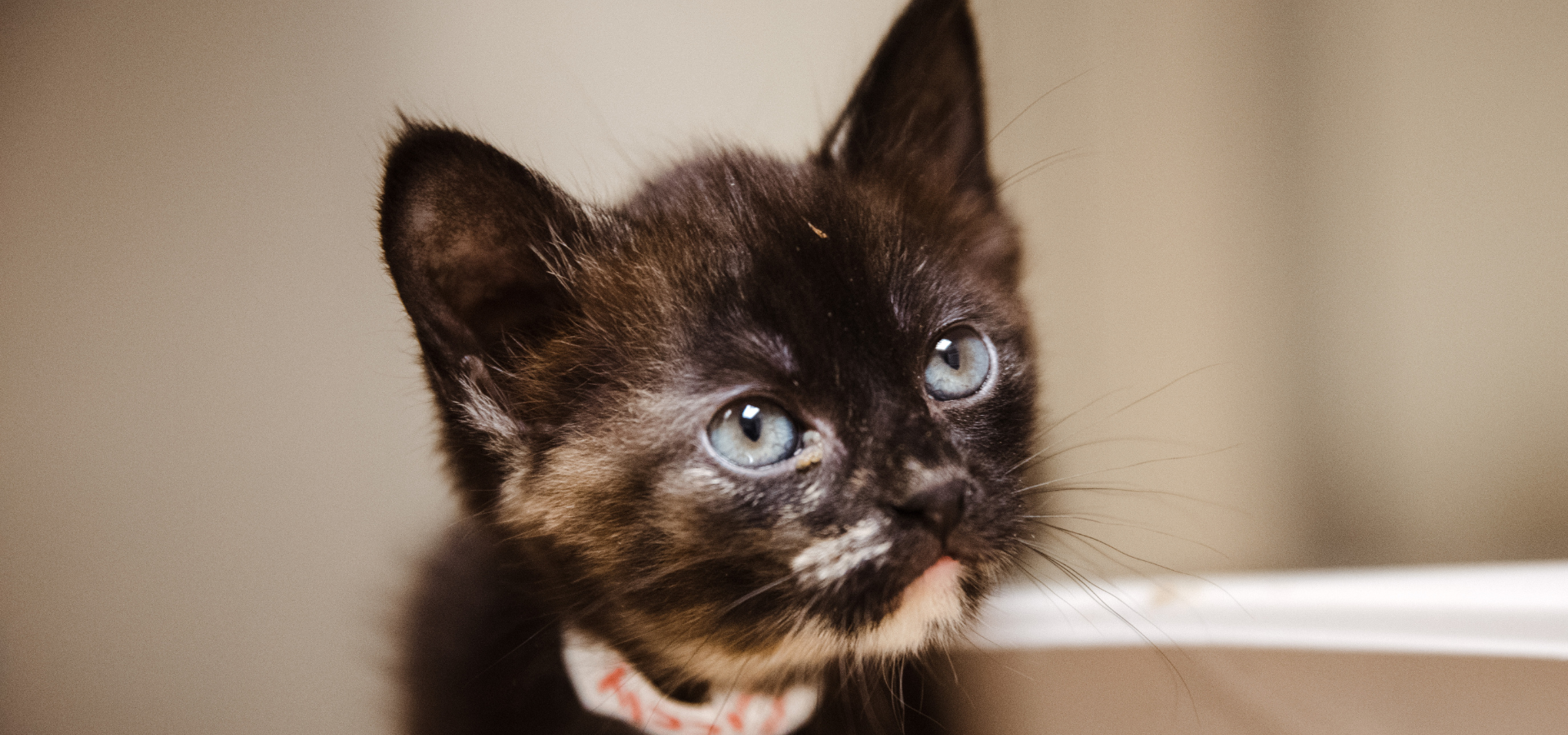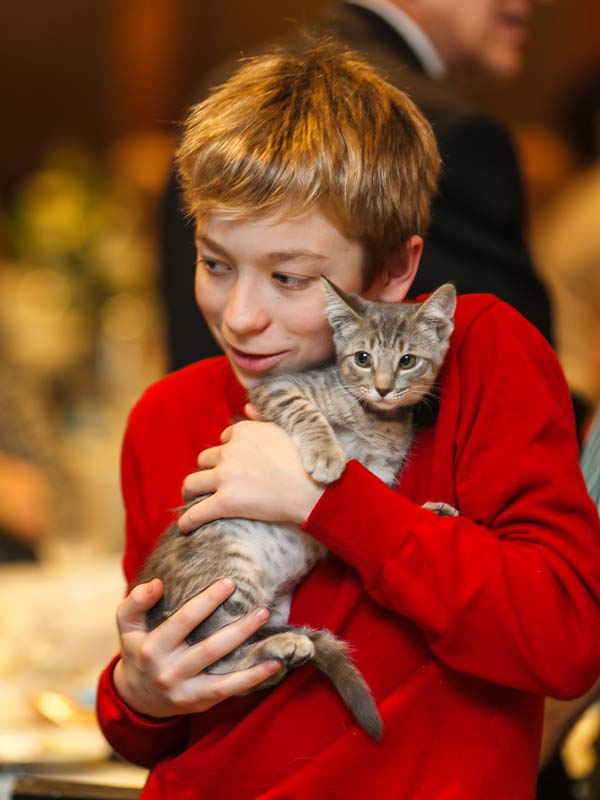Looking to Adopt a Kitten? You’re in the right place!
Please read the information below carefully and when you’re ready, fill out the kitten adoption questionnaire. As soon as a match has been made based on your selected criteria, you will be contacted. All kitten adoptions will be contactless – meaning you will not meet your kitten prior to adoption. Please note: We are averaging 20 kitten adoptions per day and demand is very high. It could be a few days to a few weeks before you are contacted. You will stay in line until you have been contacted. For comprehensive information regarding kitten adoption, please check out our Kitten Adoption Packet.
Kitten Care Information
Not all our animals are seen by a veterinarian. At the time of intake, all animals will be looked over by a technician to inspect their coat and skin, ears, eyes, mouth, teeth and gums and their weight. If there is a concern, a request will be submitted to have a veterinarian look at the animal.
Post-spay/neuter surgery
If your kitten was spayed/neutered at OHS, you will want to wait at least 10 days prior to bathing. We use a surgical glue to close the incision and it is important to keep that area clean and dry. If your pet goes out in the rain, pat the area dry with a washcloth. If you notice any redness or swelling at the incision site, please call OHS medical staff at (503) 285-7722 x414.
Upper Respiratory Infection
URI, or upper respiratory infection, in cats is very similar to a common cold in humans. OHS cats/kittens are vaccinated against URI, as well as other diseases, with the FVRCP vaccine. Symptoms include sneezing, runny nose, red/runny eyes, fever, sores on tongue/lips/nose, lack of appetite and lethargy. If you notice any of the above symptoms, please contact your community veterinarian.
Panleukopenia
Also known as feline distemper, panleukopenia is a rare but infectious viral disease in cats. Symptoms include vomiting, diarrhea, lethargy, lack of appetite and sudden death. The disease strikes suddenly and progresses rapidly, so if you see any of the above symptoms, please contact your community veterinarian immediately. If your kitten is diagnosed with panleukopenia, please call OHS medical staff at (503) 285-7722 x414.
Feline Leukemia
Feline Leukemia, also known as FeLV, is a virus that can cause a weakened immune system and result in diseases that are serious or can be fatal. We recommend that all newly adopted kittens be seen by your veterinarian and follow their recommendation for FeLV testing after adoption. Due to the very low instance of FeLV in our community, OHS does not test all kittens prior to adoption. A test is available for a $40 fee.
Rabies
All kittens that are at least 4 months of age will be given a rabies vaccine.
Food at OHS
We feed kittens two types of food twice per day: wet food and multiple options of dry food to ensure that they have a variety to choose from and are eating consistently. Whatever you choose to feed your kitten, ensure it is high in moisture content as felines are notorious for not drinking enough water.
Prepare Your Home
Before you give your new kitten the run of the house, it is important to “kitty-proof” and to make sure you have all the basic supplies. Here is a quick checklist to get you started:
- Create a safe room, such as a bathroom (close the toilet lid!), home office or guest room for your new kitten’s first few days. Place the litter box at one end with the food and water and their bed at the other. Allow your kitten to adjust at their own pace. It is especially important to keep your kitten in this safe place for at least 10 days, if you have other pets in the home.
- Remember, kittens like to explore and can get on top of most anything. Until your new kitten learns right from wrong, it is a good idea to put away breakables that may be knocked off a shelf by an exploring cat. You may find your kitten exploring in areas you’d never dream of — like your refrigerator, a washing machine/dryer, behind drawers or inside a box spring, sofa or chair. Keep an eye out to make sure you don’t accidentally trap your kitten!
- Cover electrical cords so your kitten can’t chew on them. You can also coat the cords with bitter apple liquid spray, which can be found at pet supply stores.
- Plants: Many plants are toxic to cats, so do a thorough check of your home before bringing home your pet. Click here for a comprehensive list of the most common toxic household plants.
- Toys: There are many factors that contribute to the safety or danger of a toy. Many of those factors, however, are completely dependent upon your kitten’s size, activity level and personal preference. Another factor to be considered is the environment in which your kitten spends their time.
Intro to resident pets
Quick tips for successful introduction to your resident pets:
- Confine your new kitten to a small separate area
- Swap scents with your resident pets
- Swap living areas with your resident pets Supervise all interactions between your new kitten and your resident pets
Kitten: indoors or out?
We all want our cats to live long, healthy lives. One of the ways to help ensure we maintain control over this is to keep them inside. Sadly, there are many inherent dangers for cats outside:
- Cars, trucks, etc.
- Access to antifreeze, pesticides and other toxins
- Dangers from other animals
- Risk of contracting a disease
- Getting lost or being taken
- Encountering people with malicious intent
Feline body language
Cats have varied body language. Here are some quick ways to read their subtler cues:
- Eyes: The pupils tell you a lot—widely dilated pupils indicate fear. Eye contact with a soft look is expressing nice thoughts. When your kitten looks at you, blinks, and then looks away, know that you have been acknowledged but not invited. Slow blinks indicate trust, and we encourage you to return the slow blink back to your kitten.
- Ears: These can catch the slightest sound. When held up, ears are showing that your kitten is happy, relaxed, or playful, but if held up with a more confident stance, they may not be signaling friendliness. Ears flattened are expressing fear or defense.
- Tail: A kitten holding his/her tail straight up is displaying confidence and pride. A bottlebrush tail is a sign of fear. A slow wag indicates mild annoyance (e.g. when a sleeping kitten is awakened). A slow, twitching tail wag indicates that your cat has had enough.
- Purring: This is a sign of affection and contentment for most kittens. When kittens are stressed or injured, they will sometime self-soothe with a fast, shallow purr. If you notice that your kitten is injured, please contact your veterinarian—even if they are purring.
Litter Box Training
The general rule of litter box training is to have one litter box per cat, plus an extra box for insurance. OHS uses Yesterday’s News, but we recommend any clumping litter you prefer. Here are some quick tips that will help ensure that your kitten uses the litter box:
- Place the litter box in a convenient location for your kitten to find.
- Clean the litter box every day.
- When you first arrive home with your new kitten, place them in the litter box a few times to be sure they know the location.
- You may need to experiment with different types of litter or boxes until you find the right one(s) for your kitten.
- If your kitten makes a mistake, wipe up the urine with a tissue and put the tissue in the litter box. In the case of defecation, pick up the feces with tissue and then place feces in the litter box.
- Any accidents should be cleaned with an enzyme-based cleaner or a solution of one-half white vinegar and one-half water.
- Never yell or rub a kitten’s nose in feces or urine—this does not help.
We offer virtual Kitten and Cat Training Classes! We have a 4 week class just for Kittens! There are also 1 hour specialized classes that offer many options – from introducing your new cat/kitten into the home, stopping unwanted behavioral issues to taking your cat/kitten on hikes and adventures and more! We also have virtual private training available for cats and kittens.
Scratching and How to Embrace It!
Scratching is a normal behavior and can be directed to appropriate places. Your kitten scratches to clean away scales from their nails, to mark territory and to feel at home. Providing your kitten with an appropriate place(s) to scratch can help discourage inappropriate scratching. Each kitten has their preference of the type of material they like to scratch. Try:
- Cardboard box or cardboard scratcher
- Scratching post with sisal rope
- Carpeted scratching post
- Scratching post with multiple surfaces (may include cardboard, sisal, carpet, and/or wood)
Put the scratcher near a favorite sleeping place—kittens love to stretch and scratch after a nap. Be sure to place scratcher(s) where you and your kitten spend time. A scratching post in an out-of-the-way spot probably will not be used.
If you catch your kitten scratching the furniture or carpet, a simple “no” and placing them on the desired scratching area will help. Put catnip on the “right” scratching item to encourage your kitten to use it. A laser pointer can also attract a kitten to a scratching post. Reinforce good behavior by praising and petting whenever they use appropriate places.
If you need to protect a specific item from scratches, use something to block scratching, such as plastic carpet protectors turned upside down so the plastic spikes are pointing outward. This discourages cats from walking over them. You can also use foil or double-sided tape. Products like Sticky Paws Tape® are made specifically for safe use on furniture and other surfaces to discourage scratching, while a product like FELISCRATCH by Feliway can be applied to items (such as a cat tree) that are appropriate for scratching.
Nail Trims
Keep claws trimmed. Take your kitten to a groomer or carefully trim the tips off the nails being careful not to cut the quick (the vein that runs down the nails). Ask your veterinarian to instruct you so you can do this at home. You can also buy nail sheaths (such as Soft Paws® or Kitty Caps®), which are little plastic caps that fit over nails to prevent scratching.
Keeping your cat’s claws trimmed helps, too.
If all else fails and scratching is still a persistent challenge, please call our Behavior Helpline at 503-416-2983.
Adopt a Kitten
All available kittens are listed on our adoption page.




